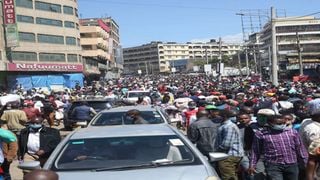
Nairobi residents go about their business at the Gikomba market on November 15, 2020. The country has witnessed a significant reduction in new HIV infections over the past 10 years.
| File | Nation Media GroupNews
Premium
114 infected daily as HIV rate takes downward trend
What you need to know:
- Kenya, the report notes, has continued to see a sharp decline in the incidence of HIV among persons aged 15 years and above.
- There have been a low HIV incidences, with 55 per cent of the counties having recorded less than 500 cases annually.
After every one hour, five Kenyans get infected with HIV as the hotspot for new infections shifts from Nyanza region to Western.
The latest Kenya HIV Progress Indicators report states that, Kenya is recording 114 HIV infections every day—quite low compared to the new infections recorded in the country 10 years ago.
Kenya, the report notes, has continued to see a sharp decline in the incidence of HIV among persons aged 15 years and above.
The report indicates the number of new infections reduced from approximately 2.8 per 1,000 people in 2010 to 1.3 per 1,000 in 2020. The national prevalence of HIV stands at 4.5 per cent with about 1.5 million people living with the virus.
There have been a low HIV incidences, with 55 per cent of the counties having recorded less than 500 cases annually.
For years, the Nyanza counties of Homa Bay, Kisumu, Migori, Nyamira, Siaya and Kisii have been topping in the number of new HIV infections. The reduction in the six counties, including Turkana, has been attributed to vigorous community strategies with services taken closer to the people. For instance, in Homa Bay, over 10 non-governmental organisations are involved in HIV care, testing and treatment.
“The underlying principle is that, when your treatment is successful, the virus is suppressed and you are unable to pass it to other people,” said Dr Mohammed Musoke, the Médecins Sans Frontières (MSF) medical coordinator in Kenya.
The Western counties of Kakamega, Busia, Vihiga and Bungoma, as well as Nairobi, Lamu, Marsabit, are now registering higher number of new infections.
‘High incidence counties’
The report states that 25 per cent of the counties, (including Homa Bay, Siaya, Kisumu, Migori, Kiambu, Kajiado, Mombasa, Kisii, Nairobi, Nakuru, Uasin Gishu and Kakamega) recorded above 1,000 new infections annually in the reporting period, hence categorised as ‘high incidence counties,’ despite some recording reduced cases.
Twenty-one counties have reduced the number of new HIV infections by more than 50 percent over the same period. At the same time, 15 counties, described as the ‘parking counties’, have minimal decline of less than 50 per cent, which means that they are neither going back nor improving. These include counties that recorded a medium incidences of between 500 and 999 a year. The counties include Mombasa, Kilifi, Taita-Taveta, Tana River, Garissa, Mandera, Wajir, Embu, Meru, Isiolo, Kitui, Machakos, Kericho, Kajiado and Uasin Gishu.
The report notes there were 41,416 new HIV infections in Kenya, with over 15-year-olds leading with 34,610 infections, and 6,806 infections in younger age groups. It attributed the trend to unsafe sexual practices and mother-to-child transmission.
The report stated that, in a day, 58 people are dying of HIV-related diseases, translating to 404 deaths a week. This year alone, about 20,997 people have died due to HIV and Aids.
Currently, HIV prevalence in the country varies between 20 per cent in Homa Bay and 0.2 per cent in Wajir.
According to NACC data, the distribution of prevalence by gender shows that females (5.8 per cent) have approximately twice the prevalence of males (3.1 per cent), with approximately 942,653 females and 565,752 males living with HIV as at December 2019. This is due to several factors, among them the scale up of various prevention and treatment programmes according to NACC.
The Kenya Modes of Transmission (KMoT) study report shows that the sources of these new infections are the 15-29-year-olds at 62 per cent, and 15-24-year-olds contributing 42 per cent of all the infections. However, less than 10 counties have achieved the first 90 of the 90:90:90 targets on testing (diagnostics).
According to the report, as at October 2020, 79 per cent of 1.5 million people living with HIV knew their HIV status, indicating a gap of 11 per cent.
Higher ART coverage
It shows that 78.9 per cent of all people knowing their HIV positive status had been initiated on antiretroviral treatment, with males presenting with a higher ART coverage of 85.3 per cent compared to 69.7 per cent among the females.
Overall performance across the three 90s among over-15-year-olds was suboptimal with viral suppression recording the lowest coverage at 71 per cent.
“This might lead to increased number of new infections and HIV related deaths in the near future,” the report states.
But compared to the adults cascade, performance within the children cascade was relatively low according to the report.
The report shows that there was an HIV identification coverage and an ART coverage of 63.5 per cent, indicating that “the gap is quite huge with regards to achievement of the UNAIDS 90:90:90 ambitious targets.”
According to the report, the predominant mode of HIV transmission is heterosexual intercourse among non-key populations aged 15-49, totalling 36,441 versus 5,893 new infections among key populations.






